James Gardner Head of SEO and Jamie Prictor, Head of PPC explain why the disciplines of SEO, CRO and PPC should be inseparable for marketers in 2024.
Traditionally Search Engine Optimisation (SEO) and Conversion Rate Optimisation (CRO) have been two disciplines. SEO has been about attracting new visitors to a landing page by ranking it highly on Google. CRO is about optimising the landing page and on-ward journey to maximise the percentage of visitors who convert.
If SEO and CRO are both seen as processes with a laser focus on what the visitors want to achieve, then we can see self-sabotaging landing pages with:
- Long bloated content to satisfy Google’s perceived need for rich content
- Calls to action in the hero banner that rush visitors into a conversion funnel before they have been able to satisfy their search intent with the content on the page.
Stepping back and considering the user experience
The common goal for SEO and CRO is to create a user experience and content that is the SINGLE BEST answer for a target audience (often, but not always, a prospective customer). Single best being anywhere on the internet.
Characteristics of a such an experience usually include:
- A fast, attractive and intuitive landing page
- The page answers the search intent directly without requiring searching the landing page or ‘thinking’ and provides simple choices for the reader to find out more information or to convert.
- Use of images, video and text that is compelling and informative
- For ecommerce, provides pricing that is attractive for the product being sold
- The conversion journey is intuitive as it presents a compelling and coherent story to the visitor. This usually includes credible proof points and references.
Google now defines these characteristics as Experience, Expertise, Authority and Trust (EEAT). However, the end purpose of these requirements was stated 25 years ago in the PhD paper written by Larry Page and Sergey Brin, the founders of Google.
“We want our notion of ‘relevant’ to only include the very best documents since there may be tens of thousands of slightly relevant documents“ (Brin, Page 1998)
Google is a recommendation service
At equimedia, we think of Google as a recommendation service. Whichever website it lists as #1 for any search query is Google’s #1 recommendation to the searcher. So, the first question to ask is:
“Why does Google think that content is its best recommendation for that search query?”
By definition, the #1 recommendation must be the highest converting website. With “converting” being whatever is appropriate for the visitor: finding the answer; making a booking or purchase; registering an enquiry; or being entertained.
It is Google’s ability to provide the very best recommendation for whatever someone chooses to search for, that has made it the dominant search engine in the western world for the past 20 years.
Conversion Rate Optimisation (CRO) is the process where all aspects of a target audience’s experience are tested to improve the conversion rate. In SEO-speak, this is usually explained as answering the user’s search intent. The key is that this is a data driven process that tests all aspects of a marketer’s hypothesis about what a prospective customer needs and wants to know in order to convert.
You now understand why SEO and CRO really are inseparable.
Examples of CRO driving SEO performance
Let us look at two examples where great CRO has produced highly ranking and highly converting landing pages.
Example 1: Transactional search – someone looking to make a purchase on an ecommerce site
Each August there is a high volume of searches for “GCSE calculators” from parents of children returning to the new school year to start their GCSE courses. One of the top-ranking pages is this one from retailer WH Smith.
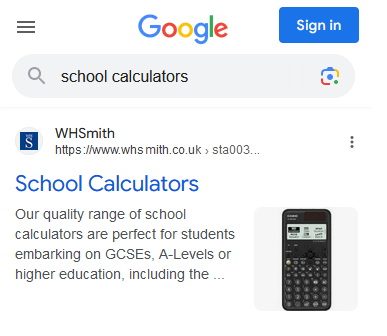
The top Organic listing from WH Smith is directly relevant to school students and the meta description states that they are “perfect for students embarking on GCSEs” and includes the #1 brand Casio. There is a thumbnail of a typical GCSE calculator. The page has been clearly optimised for the needs of the target audience - not simply keywords.
This retailer offers its expertise to help the visitors choose from its range of 16 calculators:
Quick picks: “Best for GCSEs”: CASIO FX 83 GTCW
This makes conversion very easy for most GCSE students’ parents. Their child will have the most suitable calculator from a well-known brand at a competitive price. They can add it directly to their basket from the category page or click through to find out further details.
The result is #1 ranking and high conversion.
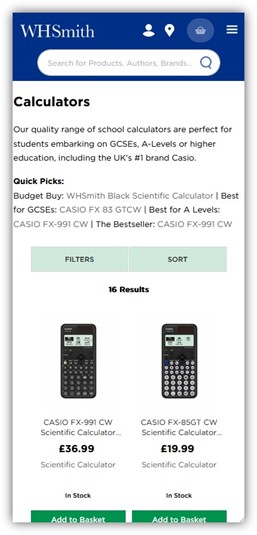
Example 2: Informational search
In this second example, someone is searching for information related to a financial service product. This is a YMYL (Your Money, Your Life) search, so the answer must be accurate, objective and from an authoritative source.

It is essential that the visitor has their query (‘search intent’) answered before they are upsold to. Indeed, they already own the product and are researching if they are entitled to make a claim. Highlighted by Google as a featured snippet at the top of SERPs is a sentence on focused blog post.
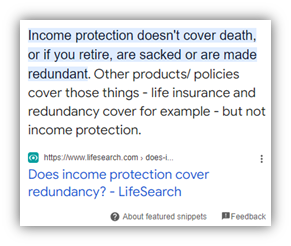
Correctly, the focus of the page the snippet is from is answering the query that the search has.
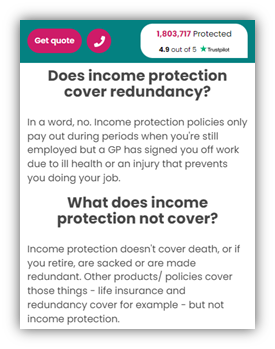
Once this search intent has been satisfied, the page has been optimised with a highly visible call to action lower down the page inviting the searcher to find out more from expert advisers.

Data-driven insights, not opinions
As marketers, we are all biased in at least several ways:
- We intimately know the product and service that we marketing. We will often speak in industry jargon not used by potential customers. Classic examples of these are: airfares vs flights and protection vs insurance.
- We may assume that the visitor has basic knowledge and is confident to ask questions.
- We have a focus on driving a conversion at the earliest opportunity which may dissuade visitors who want to maintain control, do their own research and convert when they are ready.
To counter these biases, we must optimise by testing our hypothesises through a robust testing process that uses data-led insight to inform decision making.
Here are the ways all channels contribute to CRO:
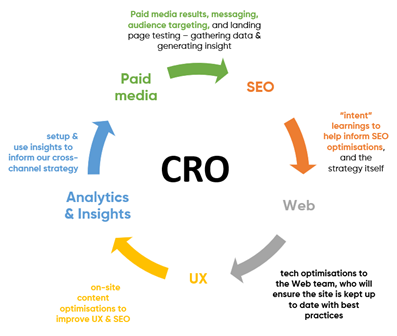
The role of paid media
Paid media, including PPC advertising have an important role that is often overlooked. Google Ads has long had a quality score (QS) for how close the ad copy matches the copy on the landing page. This is a simplistic measurement of how well the ‘scent’ is carried from the search query to the landing page; something that is vital for high conversion performance.
Optimising paid landing pages has long been a CRO discipline. Paid and Organic landing pages are trying to satisfy the same search intent. Paid landing pages have more control over the audience using it, so they provide a vital role in CRO testing. Taking the learnings and insights from Paid landing page optimisation across to Organic pages is a fast route to effective search engine optimisation.
Google Ads provides a free and effective CRO testing tool: Google Ads Experiments, which we frequently make use of.
You now understand why PPC, SEO and CRO really are inseparable!
If you would like to understand more about how to integrate your SEO, CRO and PPC optimisation projects to maximise results, please get in touch to arrange a consultancy with our experts today.
Newsletter sign up
Post Information
| Author | James Gardner |
| Channel | SEM |

